Free family chore chart templates that will get your family to do their chores. Your life is about to get easier!

Select any free printable family chore chart template and add your family members and your chore list. Divide the chores between all family members. Put the customizable family chore chart printable on the fridge or somewhere that you can see it all the time.
The following chore charts are for multiple people. We also have a chore chart for one person.
Weekly Family Chore Chart
This is a weekly chore chart for multiple kids.
This weekly chore chart has 5 versions depending on the number of family members. Each version is available in Microsoft Word, as an image, a typeable PDF file, and an Excel spreadsheet.
This customizable chore chart for multiple kids is available as a Word document with no border or with any border you like (in which case you can customize the background but not the chart). With the Word version, you can customize the chart as well.
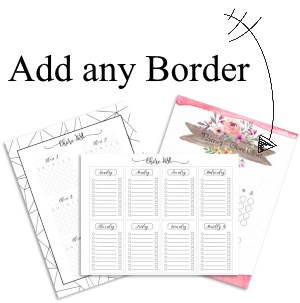
Chore Chart Maker
First, select the chore list layout then select the border.
Customize & Print101 Backgrounds Available
There is also a chore chart maker for kids chore charts with multiple kids.
Excel Chore Chart
This Excel chart has a tab for each family member (see instructions below on how to add members and change the names). There is a chore list (that you can edit) that appears for each block of time. Each chore is colored the same color.
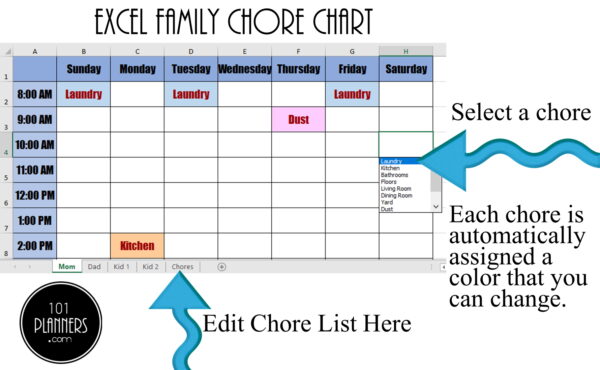
To add an additional chart for another person, right-click on the weekly schedule tab and select copy. Copy as many times as you want. Create one tab per family member. To add each person’s name, right-click on each tab and select “rename”. Type each family member’s name on each tab. To delete a person, right-click on a tab and select delete.
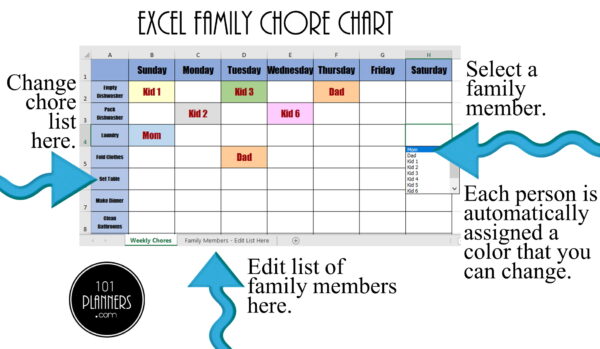
How to Get Your Family to Do Chores
Getting your family to do chores can be a challenge, but it’s an important step in teaching responsibility and teamwork. Here are some tips to get your family to do chores:
- Create a chore list: Assign tasks to each family member and prioritize the most important chores.
- Be flexible: Be flexible with the chore list, and adjust it as needed based on changes in family dynamics and responsibilities.
- Lead by example: Set the tone by doing chores yourself and demonstrating how important they are.
- Encourage teamwork: Encourage family members to work together on larger projects, such as yard work or deep cleaning, to foster a sense of teamwork and cooperation.
- Set aside time: Set aside dedicated time each day or week for household chores, so that everyone knows what to expect and can plan accordingly.
- Be positive: Be positive and encouraging when working together on household tasks, and focus on the end goal of having a clean and organized home.
- Involve everyone: Involve all family members in creating the chore list and assigning tasks, including children.
- Start early: Involve children in household tasks from a young age, giving them age-appropriate tasks that they can handle, while also challenging them to develop new skills.
- Have fun: Incorporate fun and positive reinforcement into the chore process, such as rewards for completing tasks or games to make chores more enjoyable. Make sure to take breaks and have fun as a family, in addition to completing household tasks.
- Set clear expectations: Clearly communicate the expectations for each chore, including when it should be completed and how it should be done.
- Be consistent: Stick to the chore list and be consistent in holding family members accountable for completing their tasks.
- Make it a routine: Incorporate chores into your daily routine, so that they become a habit for everyone.
- Provide instruction and tools: Provide the necessary tools for completing chores, such as cleaning supplies, laundry detergent, etc. Also, show them how to do each chore. Don’t assume that they know what to do and how to do it.
By making chores a positive and enjoyable experience, and setting clear expectations and consistent routines, you can encourage your family to take an active role in household tasks and develop a sense of responsibility and teamwork.
How to make a chore chart for the whole family
- Add all family members to the chart.
- Add the list of chores that need to be done.
- Decide on the family chore schedule and mark it on the chart.
- Use the chore tracker to ensure that all family members do their chores each day or week.
You might decide on chores that everyone has to do and additional optional chores for kids to earn money. Chores for money could be those beyond what you would expect your child to do and chores that you might otherwise have paid someone to do. Here are some chores to do around the house for money: mow the lawn, clean the car, etc.
If you decide to use this system you can use two chore charts: one for the family chores and one for chores for money (see the money chore chart below).
How to decide on the family chore list
It is important to take into account both the chores that your child can do and the time they have. For example, for a teenager allowance chart, your teenagers might be capable of doing pretty much any chore but depending on their school schedule and the time of the year they might not have too much time. For a young kid’s allowance chart, the situation is very different. The children are not capable of doing as many chores but they probably have more time on their hands. Select any allowance chore chart template below.
Here are some tips on how to decide on the family chore list:
- Involve everyone: Involve all family members in creating the chore list, including children, as it helps everyone feel invested in the process.
- Assess needs: Consider the needs of your family, such as cleaning, cooking, laundry, yard work, etc., and prioritize which chores are most important to complete.
- Consider age and abilities: When assigning chores, consider the age and abilities of each family member. It’s important to give children age-appropriate chores for kids that they can handle, while also challenging them to develop new skills.
- Be fair: Ensure that the workload is distributed fairly among family members. Consider each person’s strengths, interests, and schedules when assigning chores.
- Set clear expectations: Clearly communicate the expectations for each chore, such as when it should be completed, how it should be done, etc.
- Make it a routine: Incorporate chores into your daily routine, so that they become a habit.
- Review and adjust: Regularly review the chore list and make adjustments as needed, taking into account changing family dynamics, responsibilities, and interests.
By involving everyone in the process and creating a fair and manageable chore list, you can help build a sense of teamwork and responsibility in your family.
If you are into chore rotation you can fill out a blank chore chart with a chore list and change the names each week.
How to use colors to allocate the chores
Color coding chores on a family chore chart can significantly streamline household organization and engage family members in a collaborative and efficient way. By assigning specific colors to each family member or type of task, it becomes immediately clear who is responsible for what, reducing confusion and ensuring a fair distribution of chores. For instance, assigning blue to Dad for outdoor tasks and pink to a child for tidying their room makes responsibilities visually distinct and easy to remember. This method also adds a fun and interactive element, especially for children, making chore completion more appealing. To implement this, use a variety of colored markers, stickers, or magnets on a shared chart placed in a common area. Regularly update and rotate chores to maintain balance and interest. Color coding not only simplifies task management but also fosters a sense of ownership and teamwork within the family, making the mundane task of completing chores a more engaging and organized experience.
Allowance chore chart for kids
A kids allowance chart can be used when you give an allowance for chores. There are three ways to do this:
- Give your kids their allowance if they do their chores. You are not paying for chores but your kids have to complete their chores in order to get their allowance.
- Enable kids to do extra chores for money to get an allowance. Provide a list of chores for money and your kids decide which chores to do. At the end of the week or month, you work out how much they earned and pay them accordingly.
- In order to get their allowance, kids need to do their chores. In addition to their chores, you can offer paid chores that are above and beyond their usual tasks to increase their allowance.
Which method should you choose? It’s a matter of personal preference and parenting style. All approaches can be effective and ultimately, it depends on what works best for each individual family.
Printable Money Chore Chart for Kids
This is a chore chart with prices for kids who want to do chores to do for money. A chore chart with money value for each optional chore gives your kids the opportunity to see how they can earn extra money when they want to save up to buy something. Each time a child completes a chore he will mark the chore payment chart. At the end of the week or month, you will pay each child however much they have earned according to the chore price list.
This is a printable chore chart with money earned for some chores. Add the chore list with allowance in the left column. Add the amount that you will pay for each chore for each child.
Add 101 Borders to the Allowance Chore Chart
Customize & Print101 Backgrounds Available
Giving your child an allowance for age-appropriate chores
As your child gets older, they will probably want to have a bit of their own spending money. And, while an allowance is one way to give them money of their own, there are both pros and cons to giving your child an allowance for age-appropriate chores. Here are a few things to consider before you decide.
Should you pay your child for chores?
It’s a matter of personal preference and parenting style. Some parents believe that paying children for chores teaches the value of money and work, while others believe that chores are part of household responsibilities and should be completed without compensation. Ultimately, it depends on what works best for each individual family. I personally think that kids should not be paid for doing their basic chores. However, I do think that they should have the option to do extra chores for money because of the benefits it provides (see below).
By combining both free and paid chores, you can help children develop a sense of responsibility and financial literacy, while also making household tasks more manageable and efficient.
Why you shouldn’t pay your child for chores
Household chores like making your bed, doing laundry, and helping to prepare meals should be done because you’re part of the family. If you’re wearing clothes and eating food, there is no reason that your child shouldn’t be expected to help for free.
As part of the family, it’s important that your child learns that helping out is expected. And, paying them to do what’s expected can help raise an entitled child who feels they need to be given things they should simply be doing for free.
Paying your child an allowance for every chore makes them think that all work should be paid. Instead, teach them that responsibilities aren’t always paid for.
Benefits of paying for chores
There are several ways kids can benefit from doing chores for money:
Financial literacy: By earning money through chores, children learn about the value of money and can start to understand the basics of budgeting, saving, and spending. Giving your child money to spend can teach them financial responsibility. Since it’s unlikely they will be able to earn money from a job at 12, giving them chores to do is a simple way to teach them to manage money.
Responsibility: Assigning and completing chores helps children develop a sense of responsibility and ownership for their own actions.
Work Ethic: Doing chores for money can instill a strong work ethic and the idea that effort is rewarded.
Independence: Allowing children to earn money through chores can give them a sense of independence and self-sufficiency.
Preparing for the future: Preparing children for financial responsibilities in adulthood can set them up for success later in life.
Learning the importance of giving: When kids earn their own money, it’s a wonderful opportunity to include lessons on giving and helping those that are less fortunate than they are. You could suggest they donate some of the money. This can be to any charity, a homeless shelter, or the local Humane Society. It will help them to learn to give back.
Tips for giving an allowance for chores
Here are some tips for giving an allowance for chores:
- Be clear about expectations: Make a list of the chores that kids are expected to do and agree on a fair allowance for each one.
- Be consistent: Stick to the agreed-upon allowance and be consistent with the tasks and payment schedule.
- Encourage savings: Encourage children to save a portion of their allowance to build good financial habits.
- Reward effort, not just completion: Reward children for their hard work and effort, not just for completing chores.
- Make it a teaching opportunity: Use the chore and allowance system as a teaching opportunity to discuss the value of money and budgeting.
- Avoid linking allowance to behavior: It’s important to separate allowance from punishment or reward for good behavior. Children should receive their allowance regardless of their behavior, as it is a reward for the work they have done.
- Be flexible: Be open to adjusting the chore list and allowance amount as children grow and mature.

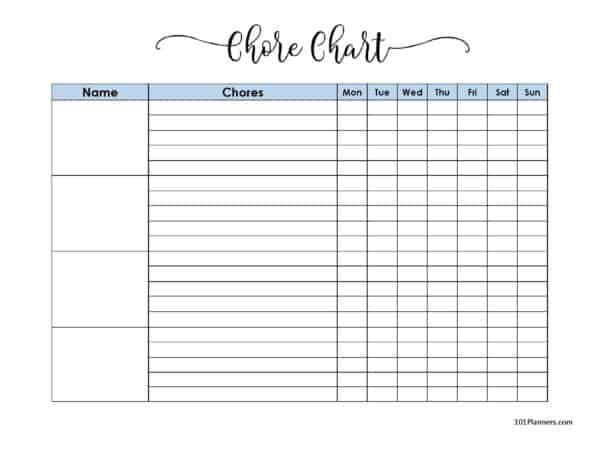


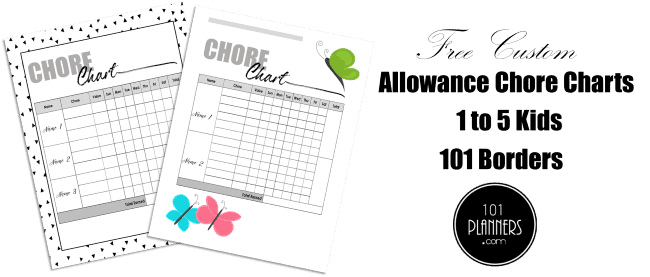
 My name is
My name is
Hi! I love your website! I having trouble with editing family member names. I am able to change the names but when I go back to the tab for the chore chart and click on the cell to choose a name in the drop down, it doesn’t show my changes, I only see kid 1, kid 2 etc. I am using the excel family chore chart. Thank you!
It sounds like you have some sort of antivirus blocking your ability to edit files downloaded from the internet. You should have a button on the top that says “enable editing”. Click on it and the problem should be solved.